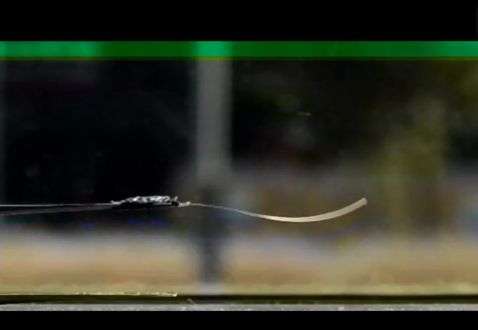New plastic material begins to oscillate spontaneously in sunlight

Place this thin layer of plastic in the sun and it begins to oscillate irregularly all by itself. Today researchers from Eindhoven University of Technology (TU/e) and the Humboldt University in Berlin present this material – the first that moves spontaneously under the influence of daylight – in the journal Nature Communications. According to the researchers, this pliable plastic is suitable as a self-cleaning surface, for example for solar cells.
Materials that move all by themselves under the influence of light – this phenomenon has been known for a number of years. However, since the source tends to be ultraviolet light, the required intensity can damage the material. The challenge was to find a material that behaves in this way in visible light, preferably unprocessed sunlight. The researchers from Eindhoven and Berlin have now succeeded in producing a thin polymer layer containing light-sensitive molecules (azo-dyes). Lying in sunlight, the thin film begins to oscillate spontaneously and irregularly.
Combination of factors
Why the plastic does this is something that the researchers cannot yet quite explain. "It seems to be a combination of factors," suggests TU/e researcher Michael Debije. "The light-sensitive molecules bend and stretch under the influence of visible light. Since these molecules are bound within the polymer network of crystal, this results in the material oscillating as if cramped. Of course, there's more to it than that – this is what we are investigating now."
Self-cleaning
One of the main possibilities for using the material is as a self-cleaning surface. "A surface that vibrates in the sun makes it difficult for sand and dust to stick to it," Debije says. Fellow researcher, Dick Broer, thinks that self-cleaning solar panels in the desert where there are no water supplies could be an option. But the researchers believe there is a whole range of other possible applications. "We have just discovered the effect; we expect that this will attract attention from many researchers from whom we will be hearing a lot over the coming period," Debije says.
More information: Kamlesh Kumar et al., A chaotic self-oscillating sunlight-driven polymer actuator, Nature Communications (4 July 2016). DOI: 10.1038/nscomms11975
Journal information: Nature Communications
Provided by Eindhoven University of Technology



















